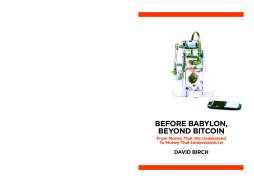
Additional Information
Book Details
Abstract
Technology is changing money: it has been transformed from physical objects to intangible information. With the arrival of smart cards, mobile phones and Bitcoin it has become easier than ever to create new forms of money. Crucially, money is also inextricably connected with our identities. Your card or phone is a security device that can identify you – and link information about you to your money. To see where these developments might be taking us, David Birch looks back over the history of money, spanning thousands of years. He sees in the past, both recent and ancient, evidence for several possible futures. Looking further back to a world before cash and central banks, there were multiple ‘currencies’ operating at the level of communities, and the use of barter for transactions. Perhaps technology will take us back to the future, a future that began back in 1971, when money became a claim backed by reputation rather than by physical commodities of any kind. Since then, money has been bits. The author shows that these phenomena are not only possible in the future, but already upon us. We may well want to make transactions in Tesco points, Air Miles, Manchester United pounds, Microsoft dollars, Islamic e-gold or Cornish e-tin. The use of cash is already in decline, and is certain to vanish from polite society. The newest technologies will take money back to its origins: a substitute for memory, a record of mutual debt obligations within multiple overlapping communities. This time though, money will be smart. It will be money that reflects the values of the communities that produced it. Future money will know where it has been, who has been using it and what they have been using it for.
Table of Contents
| Section Title | Page | Action | Price |
|---|---|---|---|
| Foreword by Andrew Haldane | xii | ||
| Foreword by Brett King | xiv | ||
| Preface | xvi | ||
| Introduction | 1 | ||
| part i | 17 | ||
| the past: money that we understand | 17 | ||
| Chapter 1 | 19 | ||
| Money is a technology | 19 | ||
| Chapter 2 | 35 | ||
| 1066 and all that | 35 | ||
| Chapter 3 | 45 | ||
| Money and markets | 45 | ||
| Chapter 4 | 59 | ||
| Crises and progress | 59 | ||
| part ii | 73 | ||
| the present: money that we think we understand | 73 | ||
| Chapter 5 | 75 | ||
| Goodbye Pony Express | 75 | ||
| Chapter 6 | 81 | ||
| Consumer technology | 81 | ||
| Chapter 7 | 95 | ||
| Moving to mobile | 95 | ||
| Chapter 8 | 111 | ||
| The case against cash | 111 | ||
| Chapter 9 | 123 | ||
| Why keep cash? | 123 | ||
| Chapter 10 | 131 | ||
| Thinking about the cashless economy | 131 | ||
| Chapter 11 | 153 | ||
| After the gold rush | 153 | ||
| part iii | 157 | ||
| the future: money that understands us | 157 | ||
| Chapter 12 | 159 | ||
| Seeds of the future | 159 | ||
| Chapter 13 | 167 | ||
| Counting on cryptography | 167 | ||
| Chapter 14 | 183 | ||
| Who will make money? | 183 | ||
| Chapter 15 | 203 | ||
| Reimagining money | 203 | ||
| Chapter 16 | 213 | ||
| Back to the future | 213 | ||
| Chapter 17 | 219 | ||
| The next money | 219 | ||
| Chapter 18 | 229 | ||
| Coda: a manifesto for cashlessness | 229 | ||
| Appendix: around the cashless world | 235 | ||
| Bibliography | 251 |
